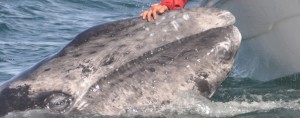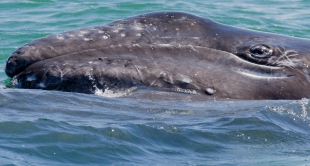They wouldn’t have the means to do it! The Gray whales were called devil’s fishes because they attacked little hunting boats in times of whaling. What moves these Gray whales in the pacific lagoons to cuddle up now?
Cetaceans – and with this we mean dolphins and whales – touch people deeply. They touch humans’ hearts. It is surprising for some guests and not explainable at first sight. In over 20 years with cetaceans I have only met a few people who were left indifferent towards the warm-blooded animals and everyone senses that you meet creatures here that are different than e.g. fishes. Not seldom dolphins and whales are looking for contact with boats and humans.
It would be exciting to know how whales perceive us. Do they know that it is us who pollute the oceans with plastic waste, radioactivity and more and that we take them away their – but also our – living space?
The little difference
What makes the difference? Is it the moment a dolphin rides the bow wave of the boat and looks at you and a magic connection is created? Is it the elegance and beauty of the animals? Or do we perceive that somebody self-conscious – a being who is aware of itself? Somebody who behaves altruistic. Somebody who is playful and curious? Somebody who has social and cognitive abilities? An intelligent creature with an attentive careful perception?
Whales touch us
But how is it reversed? Should we touch whales and dolphins, so really get hold of them? Initially the answer is clearly no. Respectful whale watching and the observation of cetaceans means to keep an appropriate distance to the animals. The sea mammals should always have the choice how near they would like to come to the boat and determine the intensity of the contact.
Exceptions confirm the rules
Quite lot of Gray whales could have seen the whale catchers’ times when they picked up the boats, brought them for capsizing and fought desperately for their life.
In 1974 happened something astonishing. At that time there was barely any Whale Watching in the pacific lagoons. Stephan Swart and his wife – a couple of Gray whale researcher – were out on the open sea with their rubber boat when suddenly a cheeky whale came nearly with their nose right into the boat. The most moving experience in both of the Gray whale researchers’ carriers, how Stephan told us last year in a conversation.
The whales “Amazing Grace” and “Nachos” did not keep to the conventions and were responsible for the fact that things took their run. Also in the next whale season the whales came quite near to the rubber boats where hands were stretched out. This has become sort of a Gray whale culture which apparently is transmitted from generation to generation. On approx. 30 percent of the tours the Gray whales approach the boats so it comes to a contact between humans and whales. We cannot call it in. Also here in on of the best organized whale watching zones worldwide, the animals determine the contact. It is barely believable: They almost demand to touch them. They seem to love it when you stroke them over their barnacled skin. They approach to the small whale watching boats, rub their backs at it and for minutes they stay really close. Mothers with calves pass their time in this way. A present and fun on both sides.
Beware – Danger of addiction!
We have been many times in Mexico to observe whales and the fascination never has decreased. When such a creature of 30 to 40 tons lies directly beside the boat, each time I am surprised, excited, and I feel touched, impressed and present in this wonderful moment meeting these strange Gray whales that seem to me like extraterrestrial species. For few years now it also sometimes comes to a kiss. Never had I thought that I ever would kiss a whale. And I hadn’t thought before that you could and should do it.
But life is full of surprises and you better never say “never”.
Susanne Braack






